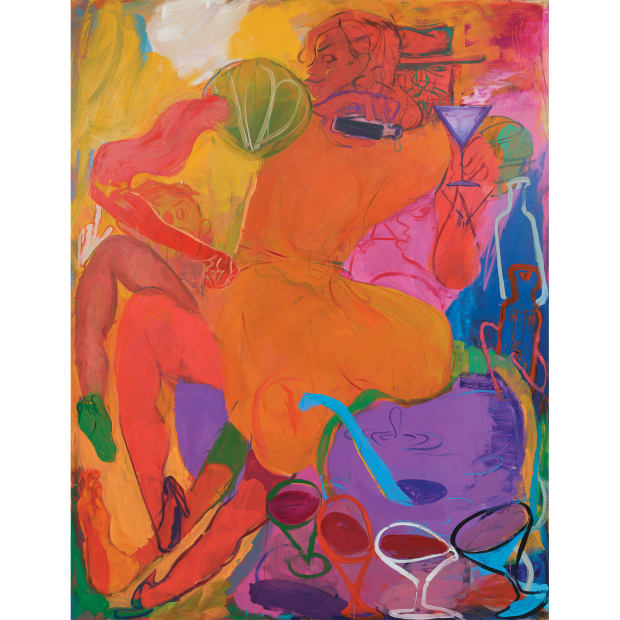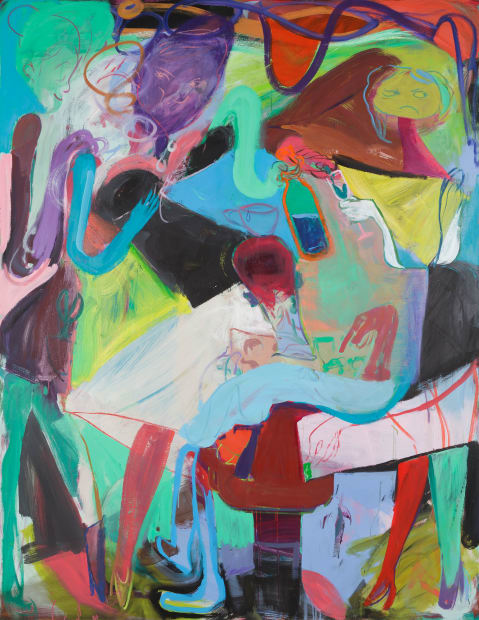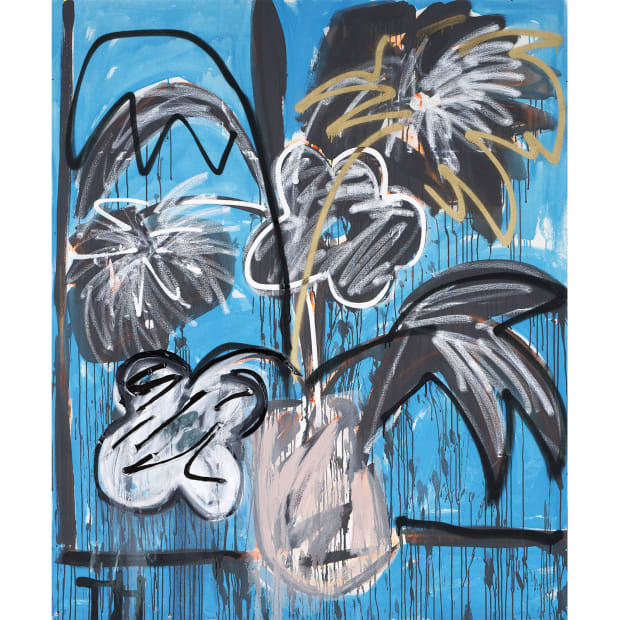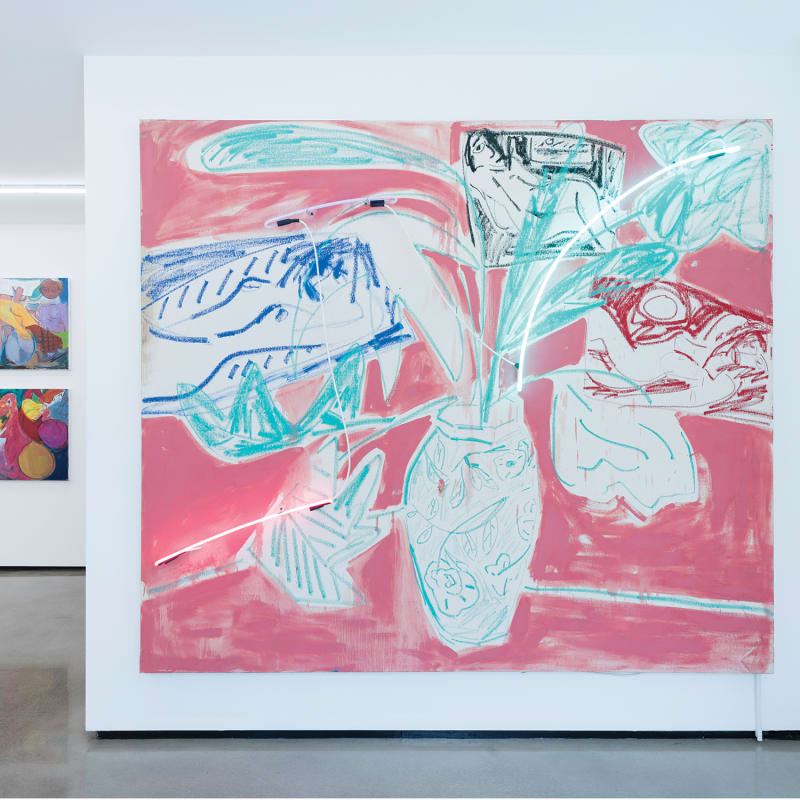JONATHAN LUX & THRUSH HOLMES: MODERNIST LUNCH
Modernist Lunch pairs the work of Thrush Holmes and Jonathan Lux; two artists with clear and confident artistic perspectives who could, certainly, both be shown as solo exhibitions. When paired together what we notice perhaps most evidently is the subversive sense of irony and nostalgia that is at play in the work of either artist. Both artists explore a brightly-coloured, often humorous, and defiantly revisionist approach to Modernism.
For both artists, familiar themes are explored in unfamiliar methods: Holmes’ work is irreverently playful; presently, the young Canadian artist’s practice has been focused on a reconsideration of the traditions of Modernist floral painting, drawing upon predecessors like Picasso and Matisse while upending these traditions with an aggressively contemporary approach. On a smaller scale, his work becomes perhaps more intimate, and exact; each articulation of these floral still-lives seemingly an homage and reaction to the history of such subject matter. On a larger scale, we see his joy in confident, sweeping gestures: the loud, unforgiving Fantasy Painting adopts a sardonic-tone, (the colour scheme reminding of the idiom ‘to see through rose-coloured glasses’), recalling Picasso’s famed 1907 painting Demoiselles d’Avignon in both its colour and casual display of nudes on offer for the viewer. Here Holmes seems eager to paraphrase Picasso: the presentation of nudes presented almost as paintings within his own painting, a splash of that ever-famed Modernist light here reimagined as a fluorescent lightbulb. Like Picasso, Holmes is interested in breaking down forms and exploring singular, bold idea. The addition of neon asks us to further consider our relationship to tradition: is it arbitrary? And can painting be simultaneously silly and well-executed? The answer of course is yes: from Gary Hume’s recent ‘deconstructed rainbow’ works at White Cube or even George Condo’s ongoing oeuvre of maniacally laughing portraits that poke-fun at traditions of painting and portraiture. There seems to be a zeitgeist that longs for relief in the often heavy-handed traditions of painting – particularly those reserved for the still life.
Similar to Holmes, Lux’s work explores nostalgia and certain themes that could be linked to Modernism. But unlike Holmes, Lux’s preference is to create a greater narrative to envelop his body of work. If Holmes prioritises monumental gestures and immediate gratification – Lux invites the viewer to observe saccharine and overtly sentimental – almost cartoon-like moments. Lux seems keen pull our interest further into the painting. It is like the recurring cartoon scene where Pepe LePeu is lured by the scent of his paramour; her odour anthropomorphised into a beckoning finger under his nose… I actually think this very image appears in a Lux painting… But once we engage with Lux, we are compelled to unravel the ongoing meta-narrative he has created. The nods to Alice in Wonderland seem to appear in everything from his subject matter to his paint handling (somehow his technique seems like a storybook gone awry!) The works feature dancing tea-pots, dollops of whipped-cream, and big Chesire-cat grins… one painting even exhibits a clinic for edamame beans. Through their suggestion of 1950’s style animation (vintage Coca-Cola or movie theatre adverts) that have somehow been reiterated as sensuous, playful, and almost grotesque. But they situate themselves squarely in the current contemporary language of painting: essayist Rose McLaren who wrote for his 2015 show at Marlborough Fine Art likens him to Ryan Mosley or Sigmar Polke – an artist with a strong, clear, perspective and the nerve and confidence to pull it all off with such effortlessness.
So while an argument could be made that Holmes prioritises the concept and idea of painting, Lux makes it all about the paintings themselves. Holmes takes a critical distance, offering semiological clues to consider how we learn to understand, critique, and decode a history of painterly images. While Lux talks about these ideas tangentially, a type of codified language of painting all explored within the artworks themselves, layered and stacked, suggestions of figures, shapes, fruits, and foodstuffs peeking through layers of paint. In Holy Mountain, an anonymous host pours tea for the viewer, and Holmes’ floral paintings could be set as the centrepiece. It all promises to be a fairly wild and wonderful lunch!
THRUSH HOLMES
Thrush Holmes’ practice navigates the so-called meta-narratives of artistic practice: grandiose concepts of biography, introspection, and materiality, all whittled down with his own distinctly ironic, colorful perspective. His method is to re-examine while elevating – and simultaneously poking-fun – at the conventions of the ‘Still Life’. Through his handling, and a tongue-in-cheek application of fluorescent neon lightbulbs, Holmes raises these objects to a fetishistic status; his signature marked prominently in arbitrary swirls of neon. These are markings of man’s territory, it seems, as he metaphorically pisses over the conventions of floral painting with gusto and flair. Bursting with energy, the paintings themselves triumph the physical properties of their materiality: paint drips and splatters become definitive marks on the canvas. For the viewer, such confident mark-making and material combinations suggest an artist at the beginning of a strong career. His work suggests a hybrid-form indebted to older traditions but somehow liberated by new contemporary modes. Holmes’ work can be found in permanent collections such as the Elton John Aids Foundation, Sony, Dreamworks and Def Jam Records.
JONATHAN LUX
Jonathan Lux’s practice is interested in the contradictory relationship between spontaneous processes and images that evoke nostalgia, fantasy, and narrative. As a viewer, his repertoire of imagery seems like rejected illustrations from some darkly humorous edition of Alice in Wonderland: teapots, Chesire smiles, dancing figures, and even smoking edamame beans populate the canvas. At once cleary defined, his technique also suggests a hard-worn, spontaneous re-approaching of the canvas. We see a palimpsest-like approach, there the artist’s decisions are evidenced through layers of opaque paint thereafter covered by transparent shapes. Often beginning as a reorganisation of (memories of) his environment, Lux’s subject matter is constantly ripe for re-evaluation. His mark is purposeful, traceable, like a record of time and place in history. As a result, the paintings reference popular culture, nostalgia and play, just as much as they reference his own process in creating them. As viewers, we are privy to his problem-solving. By combining real and fictional elements, subduing the edginess of the real to the influence of his personal prerogatives the paintings inhabit an uneasy territory somewhere between pleasure and mischief, the uncanny and the altogether bizarre. Beers is thrilled to present the artist’s first two-man exhibition after a highly successful solo exhibition with the legendary Marlborough Fine Arts in September 2015.
















